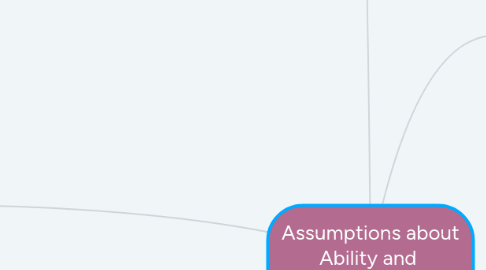Assumptions about Ability and Disability
by Chelsea T


1. Some ways to ensure that a safe, welcoming environment is created for those who are not able-bodied or who experience some form of disability are:
1.1. Ensure we use the proper terminology when talking with and about those with exceptionalities.
1.2. Discuss disability with your students so that any misconceptions or stereotypes about disabilities are challenged.
1.3. Stop perpetuating disability as a disease and that those with a disability need pity.
1.4. Provide accommodations that are specific to each student and their needs. By providing resrouces, ideas, strategies and programs that are designed to help each individual student, they will feel as though they are important and will be set up for success.
1.5. Connect with parents to find out what strategies are already in place to support their child at home.
2. 'Negative Stereotypes and Attitudes Linked to Disability' Momene, R. (2015). Negative Stereotypes and Attitudes Linked to Disability. AtlantisCorps.org.
2.1. This website shares various assumptions surrounding disability
2.2. 1. People with Disability deserve pity
2.3. 2. People with disability cannot live a productive or fulfilling life
2.4. 3. Many people with disabilities are sick or in constant pain
2.5. 4. People with disabilities are wheelchair bound
2.6. 5. People with disabilities are brave, courageous heroic and inspirational for living with their disability
2.7. 6. People with disabilities are helpless and dependent
2.8. 7. People with disabilities are to be feared
2.9. Often, those with exceptionalities are subjected to these frequent stereotypes. What is important to remember and to take away from this article, is that when we pity those with disabilities we do nothing but perpetuate the stereotype and hurt them.
3. The Opportunity to Succeed The Opportunity to Succeed. (n.d.). The Ontario Human Rights Commissions. Toronto.
3.1. Sometimes, people experience disability and other forms of discrimination at the same time. The authors of this article like to call this intersectionality. Sometimes people experience physical challenges and are a part of an already existing disadvantaged group.
3.2. Most of the time, students who are disabled and who have immigrated from another country experience the hardest time at school. Their lack of language proficiency can hinder their ability to express their needs and communicate effectively.
3.2.1. Gender can also be another factor that intersects with disability. More often than not, girls are less likely to be identified as having a learning disability, emotional disturbance or labelled as Autistic. This lack of diagnosis can leave girls without the proper accommodations and modifications that would support them in their education.
